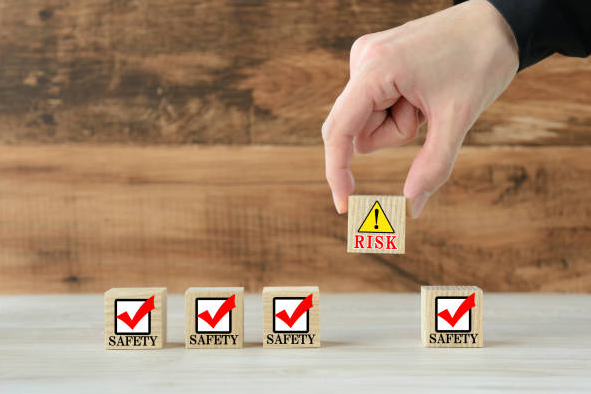
The terms “hazard” and “risk” are often heard in safety and environmental management. While they might appear synonymous at first glance, they hold distinct meanings.
In this blog, we discuss the differences between hazards and risks and the importance of understanding the differences between the two when maintaining safety in professional settings.
What is A Hazard?
A hazard can be defined as any potential source, situation, or substance that can cause harm, damage, or adverse effects.
Hazards are intrinsic characteristics or conditions that possess the potential to lead to undesirable outcomes. They can be natural or man-made, ranging from toxic chemicals and heavy machinery to slippery surfaces and extreme weather events.
Hazards exist independently of human interaction or exposure; their inherent nature classifies them as hazards. They are present in our surroundings and activities, waiting to cause harm if the appropriate precautions are not taken.
Examples of hazards include:
- Toxic chemicals in a laboratory
- A busy intersection without proper traffic signals
- A malfunctioning electrical appliance
What is A Hazard in the Workplace?
A hazard in the workplace refers to a condition, situation, or factor that can potentially cause harm, injury, illness, or damage to employees’ or visitors’ health, safety, or well-being.
Identifying and understanding hazards allows employers and organizations to implement appropriate preventive measures and controls to reduce or eliminate the associated risks.
Following are some common types of hazards commonly found in workplaces:
- Physical Hazards: Physical hazards are environmental factors that can cause harm due to their physical properties. They encompass mechanical risks like machinery and sharp objects and also dangers from noise, vibration, extreme temperatures, radiation, electricity, pressure variations, fires, and falls.
- Chemical Hazards: Chemical hazards result from any substance’s harmful chemical properties. These hazards include exposure to toxic substances, carcinogens, corrosive materials, and flammable and explosive compounds.
- Biological Hazards: These hazards are related to living things, their by-products, or biological elements that may harm people’s health, safety, or the environment. These dangers include pathogens (such as viruses, bacteria, and fungi), allergies, toxins, and other biological agents.
- Ergonomic Hazards: These hazards arise from improper workspace designs, equipment, tools, and tasks that do not fit the human body’s needs. These hazards can lead to discomfort, injuries, and musculoskeletal disorders.
- Psychosocial Hazards: Psychosocial hazards can impact an individual’s mental and emotional well-being, potentially leading to stress, psychological strain, and other adverse mental health outcomes.
- Environmental Hazards: These hazards threaten human health, ecosystems, and the natural world. Common environmental hazards include air pollution, water pollution, land pollution, climate change, and natural disasters.
See Also: 200+ Best Creative Team Names for Workplace
What is A Risk?
A risk is the potential consequence or adverse outcome that arises from exposure to a hazard. In simpler terms, risk quantifies the likelihood and severity of harm resulting from interacting with a hazard.
Unlike hazards, which are inherent qualities, risks depend on factors like the level of exposure, the vulnerability of individuals involved, and the safeguards in place. Risks are often categorized as low, moderate, or high based on the probability of harm occurring and the potential impact.
Examples of risks include:
- A low-risk scenario might involve a hazard with a minimal likelihood of causing harm, such as walking on a well-maintained pavement.
- A moderate-risk scenario could involve using a power tool with proper safety measures, where harm is possible but can be mitigated.
- High-risk scenarios encompass situations with significant potential for severe consequences, like working with radioactive materials without proper protection.
What is A Risk in the Workplace?
A workplace risk refers to the possibility of a person sustaining injuries or experiencing detrimental health outcomes due to exposure to hazards within a workplace setting.
A risk is linked to a specific hazard, and to assess the risk associated with each hazard, the employer needs to consider the following factors:
- Frequency of Exposure: The frequency at which employees or individuals come into contact with a hazardous condition greatly influences the overall risk. Higher exposure frequency can elevate the likelihood of accidents or health issues.
- Exposure Pathway: Knowing how exposure to the hazard occurs is essential. Whether the hazard is inhaled, ingested, absorbed through the skin, or encountered in other ways impacts the potential severity of the resulting harm.
- Severity of Impact: A crucial factor is the severity or potential harm caused by the injury or adverse health outcome resulting from exposure to a hazard. Assessing the possible consequences, from minor injuries to severe health conditions, helps evaluate the seriousness of the risk.
Differentiating Hazards and Risks
Let’s consider an example involving a hazardous chemical to clarify the distinction between hazards and risks. The chemical represents the hazard—it possesses the inherent quality of being harmful.
However, the risk associated with the chemical depends on the context. If the chemical is securely stored and handled by trained personnel using appropriate protective gear, the risk of harm is significantly minimized. Conversely, if the chemical is mishandled, stored improperly, or used without proper safeguards, the risk of harm increases substantially.
In essence, hazards remain constant, while risks can vary greatly depending on human actions, environmental conditions, and safety measures in place. This differentiation is crucial for devising effective strategies to manage and reduce potential harm.
Importance of Distinguishing Between Hazards and Risks
Understanding the distinction between hazards and risks is vital for several reasons:
Effective Risk Management
Individuals and organizations can enhance risk management by identifying hazards and assessing associated risks. This process may involve undertaking risk assessment training to gain expertise and implementing safety protocols, engineering controls, administrative measures, and personal protective equipment (PPE) to reduce the likelihood and severity of harm.
Resource Allocation
Recognizing the difference between hazards and risks enables allocating resources where they are most needed. High-risk areas can be prioritized for interventions and preventive measures, optimizing the use of resources.
Informed Decision-Making
Whether in personal life or business operations, informed decision-making hinges on understanding the potential consequences of actions. By evaluating risks, individuals can make well-informed choices that minimize harm.
Regulatory Compliance
Many industries are subject to regulations and standards that require risk assessments and the implementation of safety measures. Differentiating between hazards and risks ensures compliance with these regulations, reducing legal liabilities.
Conclusion
The difference between hazards and risks is more than just semantic—it’s a fundamental concept underpinning effective safety measures.
Hazards are things that can cause harm, like unsafe conditions or dangerous objects. Risks, on the other hand, measure how likely harm is to happen based on exposure and vulnerability. Knowing the difference helps us take better precautions and make safer choices.
For example, ignoring safety rules can increase risks, especially in work situations. The Risks of Working Under the Table include legal trouble, lack of protection, and no access to benefits. By understanding these risks and managing hazards wisely, we can create safer and more secure environments for everyone.







